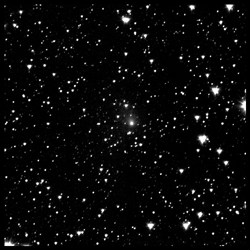EPOXI
Two intriguing investigations -- One flight-proven spacecraft
News: UMD-Led Team Begins Imaging Comet Hartley 2 with Deep Impact Spacecraft, 2010.09.08
Press Release
UMD-Led Team Begins Imaging Comet Hartley 2 with Deep Impact Spacecraft2010.09.08
 Click for larger image.
Click for larger image.
This image of comet Hartley 2 is from the first set of Medium Resolution Instrument (MRI) observations of the comet by the Deep Impact Spacecraft. In this image the comet is 119 million miles (191 million km) from the sun and 37 million miles (60 million km) from the spacecraft (it was closer to Earth than to the spacecraft!). The sun is straight "down" from the comet and celestial north is to the lower right.
Credit: NASA/JPL-Caltech/UMD
COLLEGE PARK, Md. -- Some five years after its July 4th 2005 'comet shot' was seen around the world, the Deep Impact spacecraft has begun regular imaging of a second comet target, Hartley 2. The spacecraft will continue imaging Hartley 2 during and after its closest approach on November 4, providing an extended look at the comet. However, there won't be any fireworks this time as Deep Impact's probe craft was destroyed in its deliberate 2005 collision with comet Tempel 1.
The flyby of comet Hartley 2 is the second leg of the Deep Impact spacecraft's two part extended mission known as EPOXI. During the flyby of Hartley 2, the University of Maryland-led science team will study the comet using all three of the spacecraft's instruments -- two telescopes with digital color cameras and an infrared spectrometer.
"These first images mark the beginning of the EPOXI mission's encounter campaign and the beginning of the Deep Impact spacecraft's stretch run toward Hartley 2," said University of Maryland astronomer Michael A'Hearn, principal investigator for the EPOXI mission and its predecessor mission, Deep Impact. "From here on, we expect to get better and better observations of the comet, culminating in images and data taken in the days just before and just after the November 4th flyby."
The imaging campaign, together with spectra and other data obtained from the spacecraft, will afford the mission's science team with the best extended view of a comet during its pass through the inner-solar system in history. With the exception of one, six-day break to calibrate instruments and perform a trajectory correction maneuver, the spacecraft will continuously monitor Hartley 2's gas and dust output for the next 79 days.
"Previous missions to comets, including Deep Impact, have shown us comets that seem to be very different. However, we hope data from the Deep Impact spacecraft's flyby of Hartley 2, which has a much smaller nucleus than the previously visited comets, will help us to understand why they appear so different," said A'Hearn, who won the 2008 American Institute of Aeronautics and Astronautics Space Science Award for his leadership of the spacecraft's Deep Impact mission to comet Tempel 1. A'Hearn also won the 2008 Kuiper astronomy prize for seminal contributions over his career to the study of comets, prominently including the Deep Impact mission. "The next cometary missions, Stardust NExT and ESA's Rosetta mission, will lead to additional breakthroughs in understanding what comets can tell us about the formation of the solar system,". said A'Hearn.
EPOXI is an extended mission that used the already "in flight" Deep Impact spacecraft to explore distinct celestial targets of opportunity prior to it heading for comet Hartley 2. The name EPOXI is a combination of the names for the two extended mission components: the extrasolar planet observations, called Extrasolar Planet Observations and Characterization (EPOCh), and the flyby of comet Hartley 2, called the Deep Impact Extended Investigation (DIXI). Note - while the mission name has been changed to EPOXI the spacecraft will continue to be referred to as "Deep Impact."
The University of Maryland is the Principal Investigator institution for the mission. NASA's Jet Propulsion Laboratory, Pasadena, Calif., manages the EPOXI mission for NASA's Science Mission Directorate, Washington. Drake Deming of NASA's Goddard Space Flight Center, Greenbelt, Maryland, is the science lead for the mission's extrasolar planet observations. The spacecraft was built for NASA by Ball Aerospace & Technologies Corp., Boulder, Colo.
Lee Tune
University of Maryland, College Park
301-405-4679
ltune [at] umd [dot] edu
RELEASE: 10156, Source
